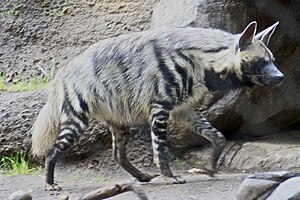Real hyenas
| Real hyenas | ||||||||||||
|---|---|---|---|---|---|---|---|---|---|---|---|---|

Striped hyena ( Hyaena hyaena ) |
||||||||||||
| Systematics | ||||||||||||
|
||||||||||||
| Scientific name | ||||||||||||
| Hyaeninae | ||||||||||||
| Gray , 1821 |
The real hyenas (Hyaeninae) are a subfamily of the hyenas (Hyaenidae). It includes three of the four living species: the spotted hyena , the striped hyena , and the blue hyena .
features
Actual hyenas reach a head body length of 100 to 160 centimeters, the tail is relatively short with 30 to 40 centimeters. The shoulder height is 66 to 81 centimeters, the weight varies between 26 and 55 kilograms, in exceptional cases up to 86 kilograms. The front legs are longer and stronger than the rear legs, which means that the back drops backwards. The paws have blunt, non-retractable claws , and there are four toes on each of the front and rear legs. Depending on the species, the fur is spotted, striped or monochrome, saddlecloth and striped hyenas have an erect mane on the back.
The structure of the skull and the teeth show the greatest differences to the aardwolves (Protelinae), the second subfamily of the hyenas. The massive head with the broad muzzle sits on a strong neck. The premolars are adapted and enlarged for bone breaking, especially the third upper and third lower premolars. Your tooth enamel has a complex structure that prevents teeth from breaking. As in all land carnivores , the fourth upper premolar and the first lower molar are developed into fangs ; these teeth are blade-shaped and are used to cut meat. The molars behind the fangs are reduced in size or completely absent. The tooth formula is I 3/3 - C 1/1 - P 4/3 M 1/1, so a total of 34 teeth. Strong masticatory muscles are associated with the strong teeth.
Distribution and way of life
The real hyenas are common in large parts of Africa as well as in western and southern Asia . They predominantly inhabit dry habitats such as semi-deserts, savannahs and bush lands, but they can cope with different habitats . They are predominantly crepuscular or nocturnal and are territorial. The territories are marked with the secretion of their anal sacs , the territories are usually relatively large and, depending on the species, cover between 20 and over 1000 km². Real hyenas often live in groups (" clans ") with a complex social structure.
The striped hyena and the black-tailed hyena are predominantly scavengers . Thanks to their strong teeth, they can break even thick bones, and their efficient digestive system utilizes all parts of an animal's body with the exception of hair, hooves and horns. The bacterial toxins contained in the carrion do not affect your digestive or immune systems. In addition to carrion, they also consume small animals they have hunted and plant material. The spotted hyenas, on the other hand, are efficient hunters who hunt between 60 and 95% of their food themselves. They mainly eat larger ungulates, but have a wide range of food.
Systematics
The actual hyenas include three of the four recent hyena species:
- Striped hyena ( Hyaena hyaena )
- Saddleback hyena ( Parahyaena brunnea or Hyaena brunnea )
- Spotted hyena ( Crocuta crocuta )
Together with the aardwolf ( Proteles cristata ), which is classified in its own subfamily Protelinae and feeds almost exclusively on termites , they form the family of hyenas (Hyaenidae).
literature
- Kay E. Holekamp and Joseph M. Kolowski: Family Hyaenidae (Hyenas). In: Don E. Wilson, Russell A. Mittermeier (eds.): Handbook of the Mammals of the World. Volume 1: Carnivores. Lynx Edicions, 2009, ISBN 978-84-96553-49-1 , pp. 234-261.
- Ronald M. Nowak: Walker's Mammals of the World . Johns Hopkins University Press, 1999, ISBN 0-8018-5789-9